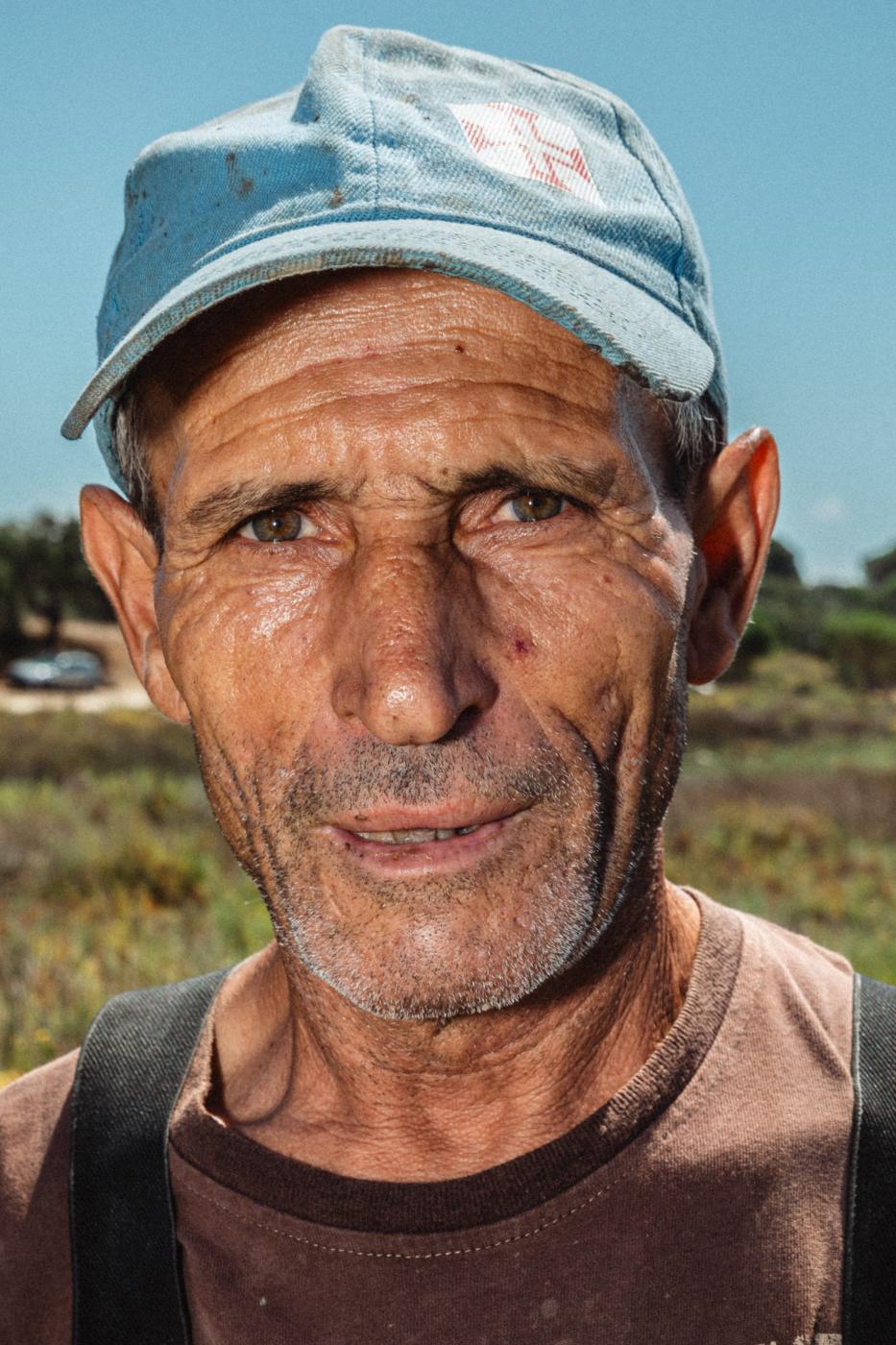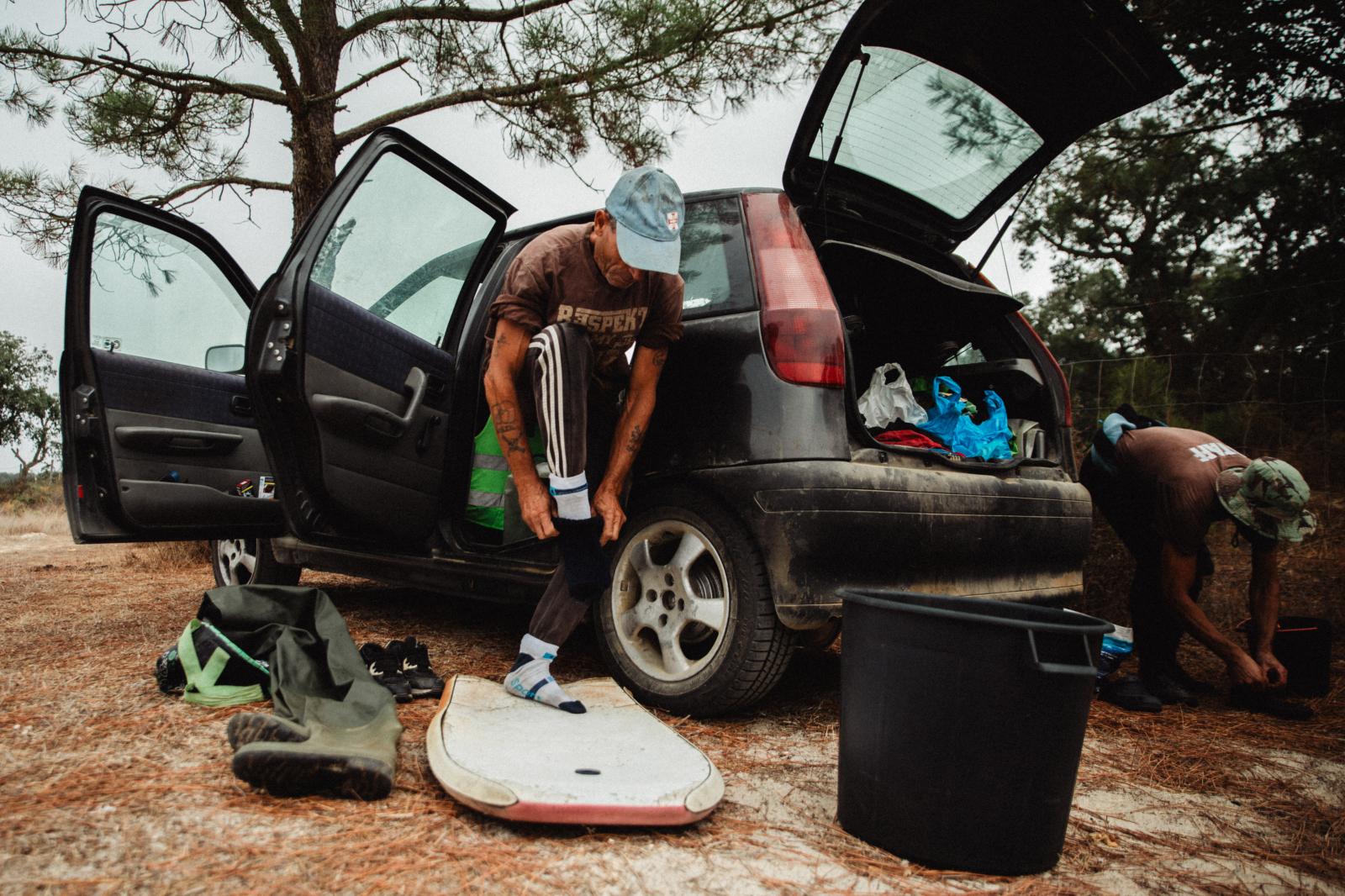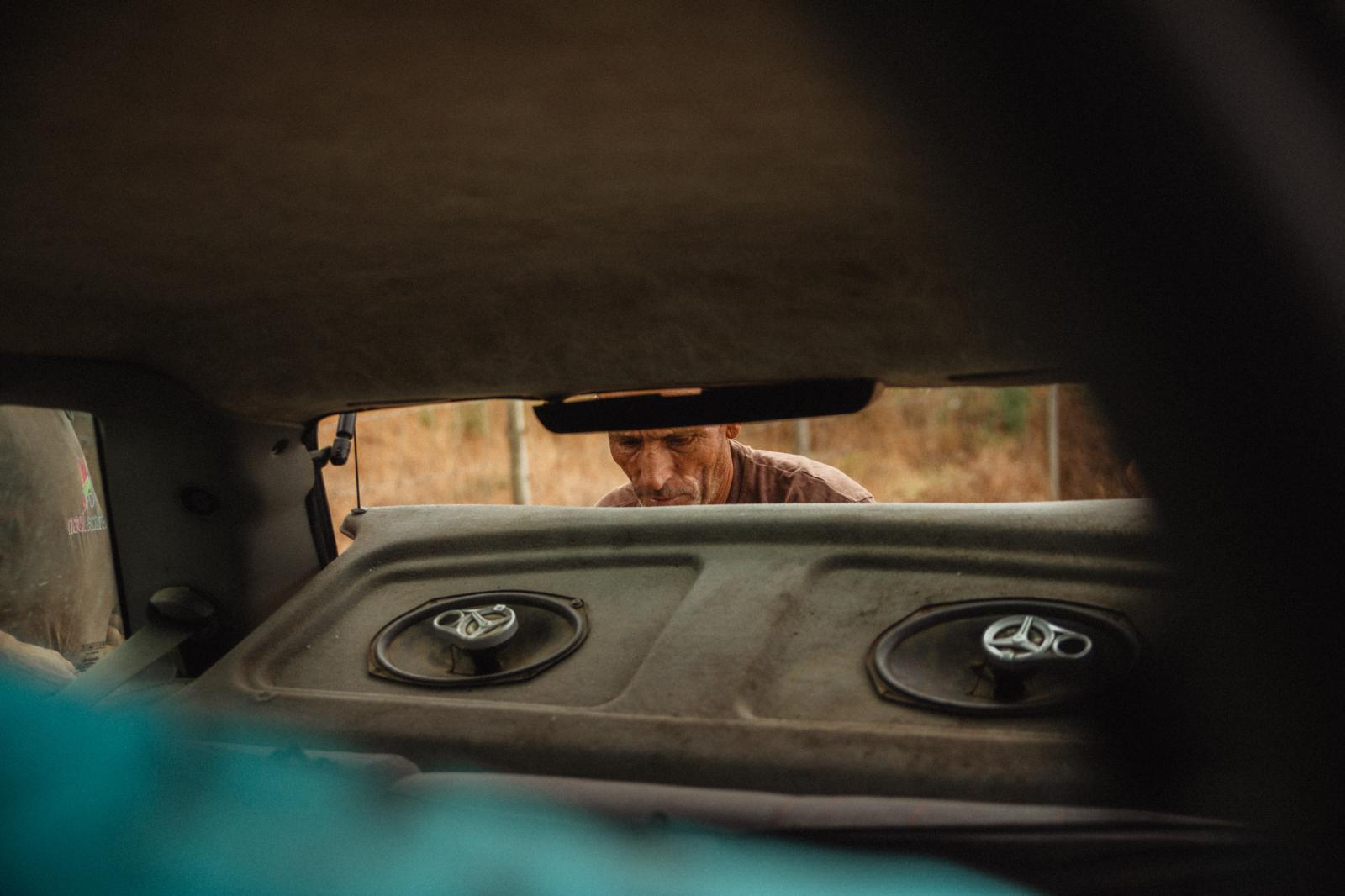Public Project
Zé Testas, the Shellfisherman of the Sado
Summary
This chronicle follows a day spent with Zé Testas, a shellfisherman working on the banks of Portugal’s Sado River. Sparked by a chance encounter during a photo walk with a friend, the author returns to document Zé’s daily routine. The narrative touches on changes in the local ecosystem, such as the introduction of the Japanese clam, increasing competition among shellfishers, and the hidden dangers of the trade. Zé Testas is portrayed as a humble, resilient man who is proud of his connection to the river and embodies a life marked by dignity, risk, and a deep bond with nature.
Zé Testas is a shellfisherman. He lives in Bela Vista, a neighbourhood on the outskirts. He harvests clams. Between tides and memories, he tells us he only went to school up until the fourth grade. And the clams he collects these days, he says, aren’t what they used to be. “This one’s japónica,” he explains, holding one up. It was introduced here in the ’90s when the native clam began to vanish — a mix of disease, overfishing, and pollution. “They brought this one in because it grows faster and can take more of a beating,” he says. The japónica adapted well to the Sado and now feeds a lot of families. But he warns us — it’s not the same as the original, and some say it’s taking over everything else.
As he gets ready for another harvest — trying to catch the low tide, which usually aligns with the new or full moon — he tells us there’s a lot of competition these days. Roma communities go out in groups, and foreign workers — mostly South Asians — show up in large numbers. But he doesn’t complain. He knows the Sado well. “Like the palm of my hand,” he says proudly. He knows where to find the good clams. And he goes for it.
The conversation flows while he prepares his gear. Then, he’s off — swallowed by the tide and silence. Pedro and I hang back, exploring the area, a place we’d never been before. I could feel the glances following us — sideways, caught somewhere between suspicion and curiosity. Two guys with cameras don’t exactly blend in.
Hours later, we spot Zé Testas coming back from afar, his smile giving away a successful haul. He’s satisfied. Says he pushed it a bit — the tide was already rising and the current was strong. He’s not sure how many kilos he got, and he’d rather not think about whether he went over the legal limit. But something sticks with me: as he sifts through his catch, he throws the smaller clams back into the river. He takes the time to explain — it’s so they can grow, so there’s something left for the future. Unlike the big groups that take everything — big and small — without giving anything back to nature.
He also tells us, in a more serious tone, that it can be dangerous. “There’ve been people who got stuck in the mud and couldn’t get out… some didn’t make it,” he says, his face tightening. The tide rises fast, the silt grabs hold, and it only takes one wrong step. It’s a risky job, despite how peaceful the river might look.
To me, Zé Testas is the image of a content man. He shared his story, the choices he’s made, and said that despite it all, he has no regrets. There’s dignity in him, pride, and a rare kind of calm that’s hard to come by.
Zé Testas, o mariscador do Sado.
No meio do meu arquivo, recuo até 2022, ano em que conheci o Zé Testas. O gosto por documentar vidas ligadas à água já se fazia notar, e foi assim que acabei por o encontrar. Eu e o Pedro gostamos de combinar saídas fotográficas para explorar histórias e paisagens com a câmara na mão. Foi numa dessas caminhadas que o Pedro conheceu o Zé Testas — uma daquelas conversas que acontecem por acaso, mas ficam na cabeça. Daí surgiu a ideia de voltarmos, desta vez para passar um dia a documentar o seu trabalho no Sado.
Zé Testas é mariscador. Vive no bairro da Bela Vista. Apanha amêijoas. Conta-nos, entre marés e memórias, que só fez a escola até à quarta classe. E diz que a amêijoa que se apanha ali já não é a mesma de antigamente. “Isto agora é japónica”, explica-nos, enquanto segura um exemplar nas mãos. Foi introduzida ali nos anos 90, quando a amêijoa-boa começou a desaparecer — por causa das doenças, da pesca em excesso e da poluição. “Meteram esta porque cresce mais depressa e aguenta mais porrada”, resume. A japónica pegou bem no Sado e hoje é o sustento de muita gente. Mas também nos alerta: não é igual à outra, e há quem diga que está a tomar o lugar de tudo o resto.
Enquanto se prepara para mais uma apanha — tentando aproveitar a maré-vazia, que julgo coincidir com lua nova ou cheia — vai-nos contando que por ali há muita competição. A comunidade cigana junta-se em grupos, os estrangeiros — sobretudo os indostânicos — aparecem às dezenas. Mas ele não se queixa. Conhece bem o Sado. “Como a palma da minha mão”, diz-nos com orgulho. Sabe onde está a boa amêijoa. E vai à luta.
A conversa decorre enquanto arruma os utensílios. Depois, desaparece, engolido pela maré e pelo silêncio. Eu e o Pedro ficamos por ali, a explorar a zona, onde nunca tínhamos estado. Senti que os olhares nos seguiam — de lado, entre a desconfiança e a curiosidade. Dois “chavalos” com máquinas na mão não passam despercebidos.
Horas depois, lá vem o Zé Testas, ao longe, com um sorriso que denuncia o sucesso da mariscada. De papo cheio. Conta-nos que se esticou — a maré já vinha cheia e a corrente estava forte. Não sabe ao certo quantos quilos apanhou, e prefere nem pensar se passou os limites permitidos. Mas há algo que me fica: enquanto separa o fruto da apanha, vai atirando de volta ao rio as amêijoas mais pequenas. Faz questão de nos explicar que é para que cresçam, para que não haja escassez no futuro. Ao contrário dos grandes grupos que apanham tudo — grandes e pequenas — sem devolver nada à natureza.
Também nos diz, num tom mais sério, que aquilo pode ser perigoso. “Já houve quem ficasse preso na lama e não conseguisse sair… alguns não sobrevivem”, contou-nos com a expressão a endurecer. A maré sobe depressa, o lodo agarra, e basta um passo em falso. É um ofício de risco, apesar do ar calmo da paisagem.
No meio do meu arquivo, recuo até 2022, ano em que conheci o Zé Testas. O gosto por documentar vidas ligadas à água já se fazia notar, e foi assim que acabei por o encontrar. Eu e o Pedro gostamos de combinar saídas fotográficas para explorar histórias e paisagens com a câmara na mão. Foi numa dessas caminhadas que o Pedro conheceu o Zé Testas — uma daquelas conversas que acontecem por acaso, mas ficam na cabeça. Daí surgiu a ideia de voltarmos, desta vez para passar um dia a documentar o seu trabalho no Sado.
Zé Testas é mariscador. Vive no bairro da Bela Vista. Apanha amêijoas. Conta-nos, entre marés e memórias, que só fez a escola até à quarta classe. E diz que a amêijoa que se apanha ali já não é a mesma de antigamente. “Isto agora é japónica”, explica-nos, enquanto segura um exemplar nas mãos. Foi introduzida ali nos anos 90, quando a amêijoa-boa começou a desaparecer — por causa das doenças, da pesca em excesso e da poluição. “Meteram esta porque cresce mais depressa e aguenta mais porrada”, resume. A japónica pegou bem no Sado e hoje é o sustento de muita gente. Mas também nos alerta: não é igual à outra, e há quem diga que está a tomar o lugar de tudo o resto.
Enquanto se prepara para mais uma apanha — tentando aproveitar a maré-vazia, que julgo coincidir com lua nova ou cheia — vai-nos contando que por ali há muita competição. A comunidade cigana junta-se em grupos, os estrangeiros — sobretudo os indostânicos — aparecem às dezenas. Mas ele não se queixa. Conhece bem o Sado. “Como a palma da minha mão”, diz-nos com orgulho. Sabe onde está a boa amêijoa. E vai à luta.
A conversa decorre enquanto arruma os utensílios. Depois, desaparece, engolido pela maré e pelo silêncio. Eu e o Pedro ficamos por ali, a explorar a zona, onde nunca tínhamos estado. Senti que os olhares nos seguiam — de lado, entre a desconfiança e a curiosidade. Dois “chavalos” com máquinas na mão não passam despercebidos.
Horas depois, lá vem o Zé Testas, ao longe, com um sorriso que denuncia o sucesso da mariscada. De papo cheio. Conta-nos que se esticou — a maré já vinha cheia e a corrente estava forte. Não sabe ao certo quantos quilos apanhou, e prefere nem pensar se passou os limites permitidos. Mas há algo que me fica: enquanto separa o fruto da apanha, vai atirando de volta ao rio as amêijoas mais pequenas. Faz questão de nos explicar que é para que cresçam, para que não haja escassez no futuro. Ao contrário dos grandes grupos que apanham tudo — grandes e pequenas — sem devolver nada à natureza.
Também nos diz, num tom mais sério, que aquilo pode ser perigoso. “Já houve quem ficasse preso na lama e não conseguisse sair… alguns não sobrevivem”, contou-nos com a expressão a endurecer. A maré sobe depressa, o lodo agarra, e basta um passo em falso. É um ofício de risco, apesar do ar calmo da paisagem.
Zé Testas é, para mim, o retrato de um homem feliz. Falou-nos do seu percurso, das escolhas que fez. E que, apesar de tudo, não se arrepende. Há ali dignidade, orgulho e uma paz difícil de encontrar.
1,681



















